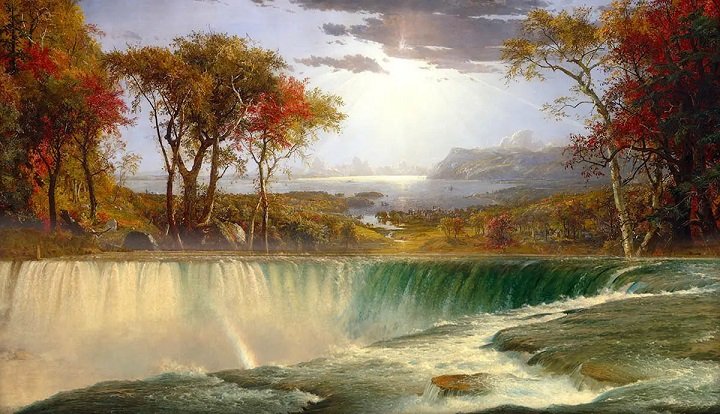The Hudson River School, an American art movement of the mid-19th century, remains a pivotal chapter in the history of American art. Characterized by its romantic portrayal of the American landscape, this school of thought brought together a group of like-minded artists who shared a deep appreciation for nature’s beauty and a desire to capture it on canvas.
Origins and Inspiration
The movement’s name, derived from the Hudson River Valley, hints at its initial source of inspiration. It was here that the landscapes, full of lush forests, majestic mountains, and serene waters, stirred the souls of these artists. The school’s philosophy was deeply influenced by romanticism, a movement that emphasized emotion, individualism, and the awe-inspiring power of nature.
Thomas Cole: The Founder
Thomas Cole, often considered the founder of the Hudson River School, was an English-born American painter. His works, such as “The Oxbow” and “The Course of Empire,” not only displayed exquisite natural scenes but also conveyed deeper messages about humanity’s relationship with nature. Cole’s vision laid the foundation for what would become a distinctly American art form.
The Significance of Cole’s Work
Cole’s approach to landscape painting was more than just capturing the physical beauty of a scene. He infused his works with themes of moral and philosophical significance. This aspect of his art is evident in “The Voyage of Life” series, which is not only a testament to his skill but also to his contemplative nature. Thomas Cole’s paintings reproductions continue to inspire artists and art enthusiasts alike. Thomas Cole’s paintings reproductions serve as a reminder of the profound impact his work had on American art.
The Second Generation
Following Cole’s footsteps, a second generation of painters emerged, who were often his pupils or followers. Among them were artists like Frederic Edwin Church, John Frederick Kensett, and Thomas Moran. These artists expanded upon Cole’s vision, exploring new landscapes and further refining the aesthetic of the Hudson River School.
Frederic Edwin Church
Frederic Edwin Church, a central figure in this movement, is best known for his detailed and dramatic landscapes. His masterpiece, “Heart of the Andes,” showcases his skill in capturing the intricate details of nature and the grandeur of South American landscapes, a departure from the traditional focus on North American scenery.
John Frederick Kensett
John Frederick Kensett, another prominent member, was known for his more subdued and serene landscapes. His work, particularly his later paintings of the Long Island Sound and the White Mountains, are celebrated for their calm and meditative qualities.
Thomas Moran and the Western Expansion
Thomas Moran, distinct for his western landscapes, played a key role in the expansion of the Hudson River School’s geographical focus. His paintings of the Yellowstone area and the Grand Canyon helped introduce these Western wonders to the broader public.
The Influence of Transcendentalism
The philosophy of Transcendentalism, with its emphasis on the spiritual over the material and the individual connection with nature, had a significant influence on the Hudson River School. This connection is evident in the works of artists like Asher B. Durand, who sought to capture the spiritual essence of nature in his landscapes.
Asher B. Durand and the Detailed Approach
Asher B. Durand, a close friend of Thomas Cole, was known for his more detailed and less dramatic approach compared to Cole. His masterpiece, “Kindred Spirits,” depicts Cole and the poet William Cullen Bryant in a quintessential Hudson River landscape, symbolizing the close relationship between art, poetry, and nature.
The Diverse Themes and Styles
While the Hudson River School artists shared common themes and objectives, their styles and subjects were diverse. Some, like Albert Bierstadt, were known for their dramatic, almost theatrical landscapes. Others, like Jasper Francis Cropsey, focused on the vivid portrayal of autumnal scenes.
Albert Bierstadt and the Luminism Touch
Albert Bierstadt, renowned for his large-scale landscapes, often incorporated elements of luminism, a style characterized by attention to detail and an emphasis on the effects of light. His works, such as “Among the Sierra Nevada Mountains, California,” are noted for their dramatic use of light and shadow.
Jasper Francis Cropsey and the Autumnal Glory
Jasper Francis Cropsey’s fascination with the autumn season resulted in some of the most vibrant and colorful landscapes of this era. His use of rich, warm colors captured the essence of the American fall, as seen in “Autumn on the Hudson River.”
The Decline and Legacy
The Hudson River School began to decline in popularity towards the end of the 19th century, as other art movements like realism and impressionism gained prominence. However, its influence persisted, shaping the course of American art and contributing to the conservation movement.
The School’s Contribution to Conservation
The Hudson River School played a crucial role in the early American conservation movement. The artists’ portrayal of untouched, idyllic landscapes helped raise awareness about the beauty of the American wilderness and the importance of preserving it for future generations.
The Enduring Impact
Today, the works of the Hudson River School are celebrated for their historical and artistic significance. They offer a glimpse into America’s past, capturing the awe-inspiring beauty of a landscape that was largely uncharted at the time.
Conclusion
The Hudson River School, with its unique blend of art, nature, and philosophy, holds a special place in the annals of American art history. Its artists, through their remarkable visions and skilled brushwork, created a legacy that continues to inspire and captivate audiences around the world.
